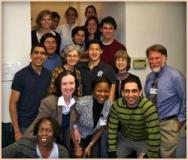In almost every village, town and city, there are key organizations devoted to some or all aspects of sustainability and livability. Their commonality is to be more than the sum of their stated business, and they embrace the trends and principles we have advanced.
They include small and not so small businesses that provide an economic structure that extends into value-based community participation; social services that enhance connections and civility; centers providing healthcare; activists devoted to the history, preservation and vitality of the environment, buildings, ethnicity; libraries, schools and cultural centers for education and the arts.
Most towns and cities in the USA of any size have a community foundation(s). In Seattle, the Bullitt Foundation, under the leadership of long-time environmental lawyer, Denis Hayes, plays an active role in assembling capital and mobilizing community will to move towards sustainability. In Davis, California, through the leadership of David Thompson, Twin Pines Foundation has been the architect of housing cooperatives, stressing the targets of students and seniors, and insuring that units are set aside for those with limited means.
The most grass-roots of institutions serving communities are consumer cooperatives. Cooperatives are a world-wide phenomenon, with their own systemic ideology (“one member, one vote”) but the focus is always local.
The financial version of cooperatives are credit unions (though there are also cooperative banks). Credit unions are owned by their member/depositors and oriented towards investment in the needs of their communities.
In Canada, the Van City Credit Union is a major player in community-oriented development. With half a million members, and 17.1 billion in deposits, Van City ranks as a powerful financial institution in Vancouver, with a deep commitment to values of social and environmental responsibility, and serving as an organizing nexus for sustainable projects.
While big banks gobble up localities, credit unions represent hundreds of millions of members and a system that is both reliable and which unites communities. Credit Unions are part of the cooperative movement which extends from finance into food, housing, large and small businesses, and offer a stubbornly independent model of how life can be organized.
In Brooklyn, New York, the Park Slope Food Co-op meets the needs of its thousands of members for healthy food, reasonable prices, and a lively center of community. Its bulletin board and website speed communications.
Local business has been fighting a losing battle for decades against suburban malls, box stores, and dominating, well-financed franchise operations which take advantage of economies of scale in purchasing, with name recognition through national media buys. Nevertheless, many town and neighborhoods have merchant associations that present Main Street as an attractive destination, local farmers collaborate on weekly farmer’s markets, and community-oriented businesses like Ben & Jerry’s blur the line between national/global and local.
The company has had its share of controversy, but always seems to come out smiling. It’s sort of a crazy flagship for an emerging paradigm, but we could do worse. After establishing itself as America’s favorite loopy ice cream, B&J’s survived the acquisition by a giant food conglomerate, Unilever, with its integrity intact, even altering the corporate culture. Over the years, it has navigated the challenging waters of competitive commerce, while attaching itself to virtually every progressive cause.
In Burlington, Alan Newman had his start with Gardner’s Supply, left to launch Seventh Generation with Jeffrey Hollander, and continued his mercurial career by founding one of the more successful craft breweries, Magic Hat. As with Ben & Jerry’s, not only have each of these businesses expressed their values through their products, but they have also funded many non-profit organizations and created positive workplaces. They see themselves as part of their community. Even further, their success has set a high standard for a wider definition of productivity, challenging young entrepreneurs and raising issues for more traditional managers and stockholders.
Private, non-profit organizations are often the leader in the viability of place. Bethesda Green, founded by Dave Feldman, has successfully brought together small business, public sector agencies and services, non-profits, activists, even financial institutions and multi-nationals that have a local presence. The goal is achieving an over-all green design for their town through cooperative promotions, fairs, workshops, a focus on recycling, discount programs for local patronage. It has attracted the participation of the usually conservative Chamber of Commerce by making the case that “green” offers practical benefits, as well as future hope. Nearby towns in Maryland have established their own versions, and Dave went on to develop a training model for local administrators and activists to achieve the necessary synergies and systems in their localities, starting with the mid-Atlantic states, under the rubric of “The Livability Project.” More recently, Green America chose him as Director of its Center for Sustainability Solutions.
Healthcare is fundamentally local, whether delivered by large hospitals, Minute Clinics, small practices or school nurses. Federally Qualified Community Health Centers like CHC, Inc., in Middletown, CT are the safety net for more than 20 million Americans, offering a critical mix of primary medicine, dental and behavioral healthcare through more than 1300 Centers.
Working outward from a base in Middletown, Connecticut, CEO Mark Masselli and Senior VP and Clinical Director Margaret Flinter have led the development of a model of primary healthcare delivering medical, dental and behavioral health that serves 130,000 patients in a dozen cities, maintains high standards of care, and is on the cutting edge of technology.
CHC Inc. has an operational model of semi-autonomous sites combined with core support functions. Its advantage is the capacity to swing resources to bear on problems that transcend individual sites, while retaining local responsiveness to varying communities and situations. The points of coordination are (1) leadership, (2) administrative and technical support, (3) pods where clinical staff work together, (4) public outreach and intake. CHC Inc. is another exemplar of a more distributive economy.
CHC operates in a fashion conducive to community, yet in tune with the needs of a sophisticated society and modern technology. Patients check in by touchpad kiosk, their health is monitored via electronic medical records, maintaining a close relationship with consistent providers. Enter the buildings, and whatever the health concerns, patients know they are in trustworthy hands. The net effect for patients is a one-stop, care visit, where even most lab testing and in some sites, pharmacies are on site. As CHC has become a respected and leading player in primary care, warm hand-offs to specialists and collegial relationships with local hospitals and academic institutions have become the rule.
Given the scale of health care and the size of the USA, there are a plethora of institutions and associations which offer overlapping coordination or competition. CHC, Inc., for example, is a member of NACHC, which includes all the nation’s health centers, and in a less formalized way a small group of the larger centers which have found it useful to share best practices. There are also dozens of professional organizations serving the needs of clinicians and administrators.
Public libraries, parks, playgrounds, senior centers and community gardens have a long and honorable tradition, while adapting to changing patterns and needs. Some institutions and initiatives like the HUBs are new: HUBs are located in major cities around the world (including Paris, Johannesburg, NY, London, Abu Dubai, SF, Melbourne, LA, etc) and provide a lively, collaborative workspace where young entrepreneurs driven by social and environmental concerns, as well as the profit motive, can jam and bring their ideas to fruition.
An example of that entrepreneurial spirit mixed with social concerns is Envirolution, launched in 2007 by two recent Yale graduates, Alex Gamboa and Anton Cannon, to signal a new generation it was time to take control of its destiny. It sought to directly address the environmental problems they were due to inherit. The successes and struggles of Envirolution are informative in understanding the potential for change.
In Nevada, with the leadership of Alex, Envirolution has worked with school systems on a state-wide basis to supplement science curriculum with exciting and practical teachings and projects around sustainability. Meanwhile, in New York City, Antuan developed Win-Win, which rapidly has become the premiere energy efficiency trainer for a broad spectrum of class and educational backgrounds in the area, with a high percentage of successful job placements for its graduates.
Maintaining a partnership between the two entities, however, and protecting the bottom line was an ongoing challenge. Whatever the values and ideals that make these Exemplars congruent with a new paradigm, there remains the challenge of designing programs and business plans, and then executing.
In 2013, the NY operation was split off as a for-profit, Envirolution One. The intent is a long-term relationship between the two entities, with a progression from environmental education in the younger grades; to a curriculum loaded with projects in the higher grades; leading to job training as preparation for joining the workforce – all part of participation in designing and implementing a sustainable future. But nobody said it was going to be easy.
As a generalization, it could be said that there is a complex of trends which these businesses and community support organizations exemplify: open source information, sharing, best practices, distributive rather than centralized, collaboration. Further, implicitly or explicitly they recognize the interdependence of human society with the environment, their roots are local, and they tend to think about the long-term implications of present actions, and assess success on benefit to the community, rather than a strictly monetary basis.
What they are less unified about is the line between open and closed. Along with the communities and jurisdictions they serve, the boundaries are less clear about the mixing of cultures, the demarcation between neighborhoods, the values that should be universal.
Community Health Centers and most hospitals and practices accept all comers on the basis of need, but have a harder time with issues which reflect deep cultural or religious divides. Clinics which offer abortion services are still being picketed and restrictive laws enacted (though mostly rejected by the courts). Vaccinations, as a critical public health intervention, are considered an invasion of privacy and a probable government plot by the paranoid and Luddites. Addiction and criminalization mixes with real pain to confuse the prescription of opioids.
Contradictions are inherent. If a local complex of businesses and community organizations rejects the presence of national fast food chains on Main Street, is that an example of local integrity? Where is the line between individual choice and community standards? When Uber began to make serious inroads in the taxi business, traditional companies and drivers who labored under restrictive rules and paid big bucks for their medallions cried foul.
It seems that open and closed are not synonyms for good and bad. Open source has encouraged innovation, but to the extent we dwell in a monetized economy, there’s going to be an argument for intellectual property rights. That battle has been fought over music, copyright, cheaper means of distributing through Kindle, and every other electronic application. At the extreme, these struggles could also be labeled as invitations to agoraphobia and claustrophobia: chaos from no limits against stultification from too many; out of the box or in the box.
Another aspect of conceptual complexity is that interventions made on a community level often slide up to the mainstream and vice versa. The Peace Corps and AmeriCorps are systemic innovations which play out on a local level, as the Volunteers engage with their towns and villages. If enough success attends these local engagements, a case can be made for extrapolating local programs into a system of national service.
The play between community interventions and mainstream systems is ongoing, and has much to recommend it. Perhaps the best outcome is for cities to more explicitly become a laboratory for the mainstream; while the amassing of information about the global society leads to identifying opportunities for smaller jurisdictions.
Business and Support Organizations Library:
- AirBnB
- Ben & Jerry’s
- Bethesda Green and the Livability Project
- Bullitt Foundation
- Community Forklift
- Community Health Center, Inc.
- Dharma Merchant Services
- Envirolution One
- Galeria Namu
- Generations: Grandparents Raising Grandchildren
- Habitat For Humanity
- Natura
- Self-Help Credit Union
- Seventh Generation
- Tesla Motors
- Twin Pines Foundation
- Uber
- Van City Credit Union
- Zip Cars

















